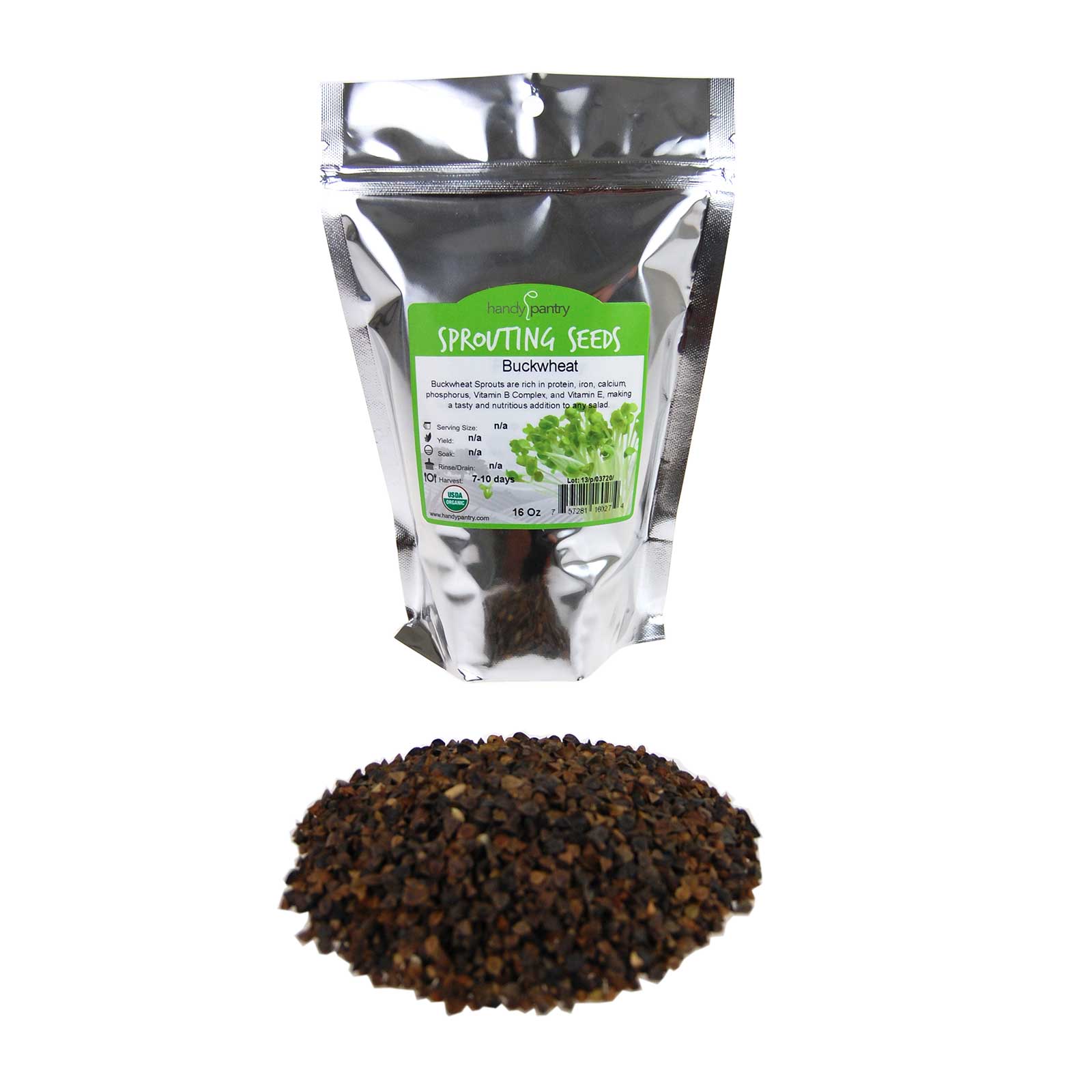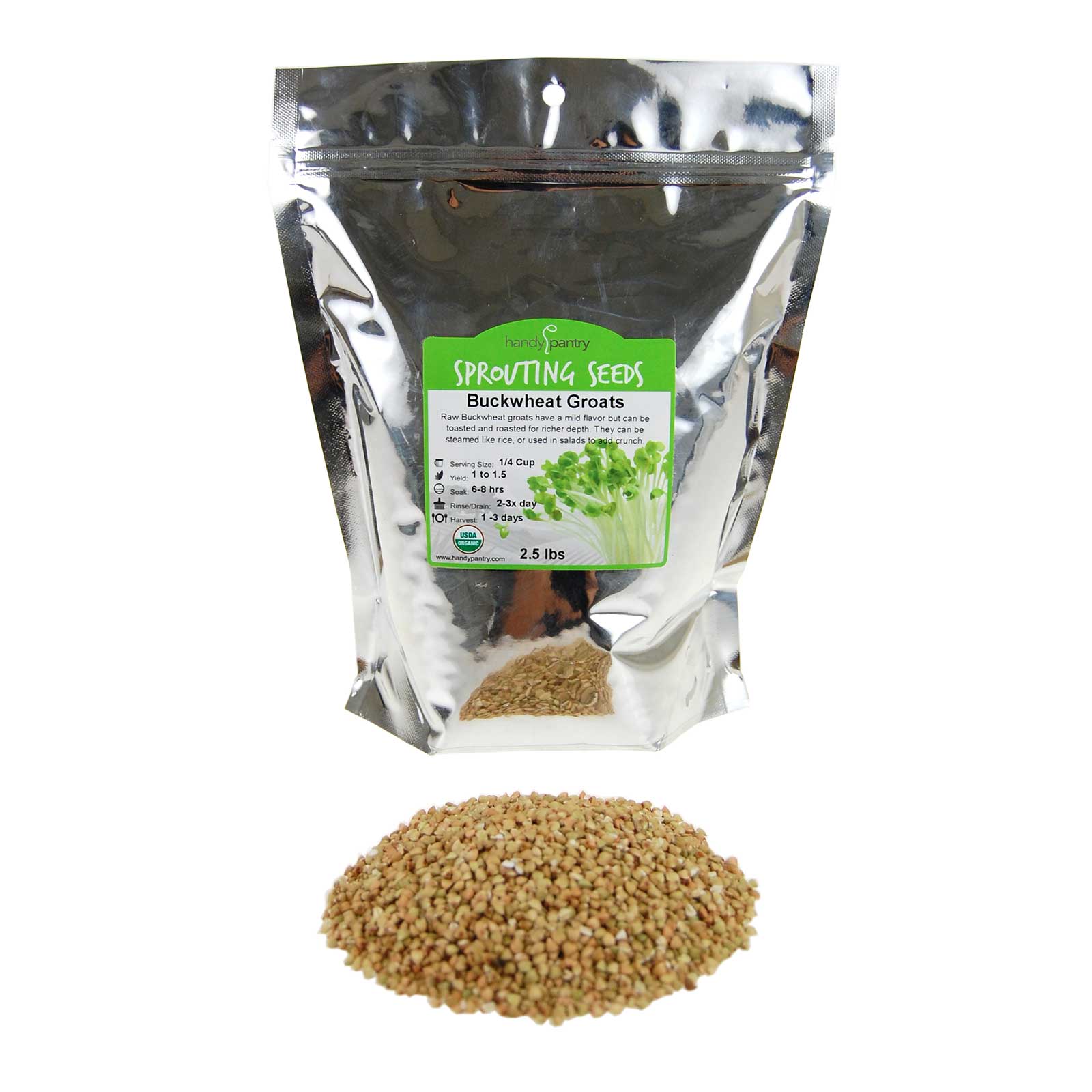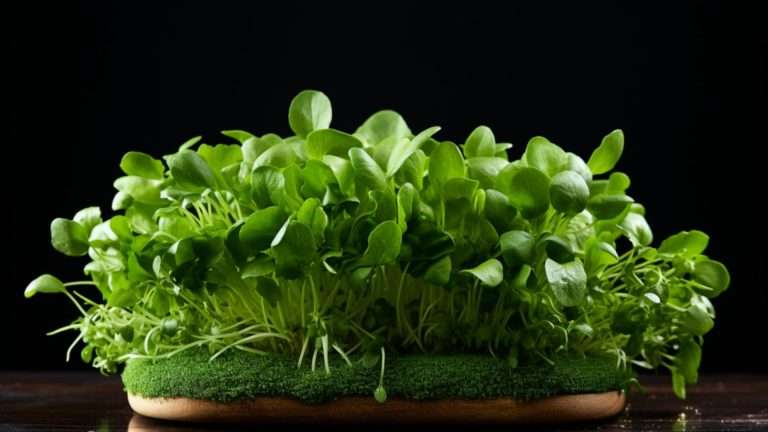Buckwheat Microgreens: Transform Your Diet with This Amazing Superfood
Some of our posts on Microgreensguru.com contain affiliate links. If you click on an affiliate link and make a purchase, we may receive a commission. Clicking on an affiliate link that earns a commission does NOT result in additional charges or costs you extra. Earnings from affiliate links help keep this website running. See our full affiliate disclosure here.
Buckwheat microgreens are young seedlings of the buckwheat plant, harvested after the first pair of true leaves emerge, usually 7-14 days after germination. Despite the name, buckwheat is not actually related to wheat but rather is a fruit seed closely related to rhubarb and sorrel. Buckwheat microgreens pack an incredible nutritional punch – they can contain up to 40x more concentrated nutrients than mature buckwheat greens. These tender greens add vibrant color with their dark green leaves and bright pink stems. And they provide a delicious flavor burst with their fresh, earthy, mildly tangy taste.
Buckwheat microgreens are often referred to as a superfood due to their stellar nutritional profile. Some of the key nutrients found in buckwheat microgreens include:
- Manganese
- Magnesium
- Copper
- Zinc
- Iron
- Antioxidants
- Amino acids like lysine
These compounds boast a wide array of health benefits which we’ll explore more later. It’s also important to note that despite having the word “wheat” in the name, buckwheat is 100% gluten-free. This makes buckwheat microgreens an excellent choice for anyone following a gluten-free diet.
Key Takeaways on Buckwheat Microgreens
- Buckwheat microgreens offer concentrated nutrition with high levels of vitamins, minerals, antioxidants, and amino acids compared to mature buckwheat greens.
- They provide health benefits like improving immunity, fighting inflammation, regulating blood sugar, and more.
- Buckwheat microgreens have a signature flavor profile – earthy, nutty, tangy, and fresh.
- They are gluten-free and suitable for restrictive diets, except for those with buckwheat allergies who should avoid.
- Proper soil, lighting, temperature, and humidity are key for successfully cultivating buckwheat microgreens.
- Buckwheat microgreens shine when added to smoothies, sandwiches, pizzas, salads, and as garnishes.
- Look for vibrant, perky microgreens without moisture or defects when purchasing. Refrigerate promptly.
- Ongoing research and culinary experimentation will drive buckwheat microgreens into the mainstream as their benefits become more widely known.
- Adding nutritious buckwheat microgreens to your diet provides an easy way to boost nutrition, flavor, and visual appeal.
How Buckwheat Microgreens Are Grown
Cultivating buckwheat microgreens begins by soaking the seeds in water overnight prior to planting. Then the seeds are spread densely atop a sterile soil medium in trays. The trays are kept covered in darkness for 2-4 days to allow the seeds to germinate. Once the first sprouts emerge and lift the cover, the tray is exposed to light to encourage growth. LED grow lights work perfectly for growing buckwheat microgreens indoors.
Proper care during the 7-14 day growing period involves maintaining consistent moisture and the ideal temperature range. Watering should be done gently from the bottom tray to avoid damaging the delicate greens. Humidity levels around 70% are optimal. Within 1-2 weeks, the microgreens will be ready to harvest by snipping with clean shears just above the soil line. They can then be rinsed, dried, and stored for use in recipes or eaten fresh.
The History of Buckwheat
Buckwheat has an ancient history as a food source, domesticated as early as 4000-6000 BC in the Balkans. It then spread throughout Europe and Asia, becoming an important staple crop especially valued for growing well in poor soils. Buckwheat flour, noodles, and groats are used extensively in Russian, Chinese, and Tibetan cuisines. The tiny but mighty buckwheat microgreen is a more recent phenomenon, emerging as a specialty produce item in the 1990s health food movement.
Growing Buckwheat Microgreens
Cultivating a healthy crop of buckwheat microgreens requires close attention to multiple factors – from the soil and seeds to the temperature, humidity, lighting, and harvesting techniques. Careful control over the growing environment and processes leads to tender, flavorful microgreens bursting with nutrients. This section provides tips and guidelines for each step of the buckwheat microgreen growing process. Follow these best practices to achieve an abundant harvest of beautiful buckwheat microgreens.

Whole buckwheat can be sprouted and grown into microgreens / buckwheat lettuce. The who… [More]

Organic buckwheat groats (hulled, shell removed) don’t sprout well, but are great toast… [More]

Whole buckwheat can be sprouted and grown into microgreens / buckwheat lettuce. The who… [More]
Table 1: Troubleshooting Buckwheat Microgreen Problems
| Problem | Solution |
| Leggy growth | Use supplemental lighting, reduce spacing |
| Mold | Lower humidity, increase air circulation |
| Poor germination | Ensure good seed-soil contact, proper watering |
Selecting the Best Soil for Buckwheat Microgreens
Choosing the right soil is crucial to grow healthy, vibrant buckwheat microgreens. The ideal soil should be sterile, lightweight, and fast-draining. A soilless mix of peat moss and vermiculite works perfectly. The soil should also have a neutral pH around 7.0. Before planting, the soil should be pre-moistened and tamped down gently to form an even surface. Buckwheat grows best in soil compared to hydroponic media.
Key soil considerations:
- Sterile and nutrient-rich to prevent mold
- Peat moss provides moisture retention
- Vermiculite improves drainage
- Loose texture for easy root growth
- Pre-moisten and flatten before seeding
Optimizing Sunlight, Temperature, and Humidity
Proper environmental conditions are vital for buckwheat microgreens to thrive. Buckwheat prefers consistently warm temperatures around 70°F (20°C). Cooler temperatures below 60°F (15°C) will slow growth. Humidity should be maintained around 70% for best results. Gentle air circulation helps strengthen stems as well.
For lighting, LED grow lights are ideal, providing full spectrum illumination. Buckwheat needs 14-16 hours of light per day. Direct hot sunlight can dry out the tender greens.
Buckwheat Seed Germination and Growth Timeline
Under the right conditions, buckwheat seeds will sprout quickly. Here’s a general timeline:
- Soaking seeds for 8-12 hours
- Seeds germinate in 2-4 days
- Growth in darkness 4-5 days
- Ready for harvest in 7-14 days total
Buckwheat microgreens will first emerge with pale yellow leaves while shedding their seed hulls. With light exposure, the leaves quickly turn vibrant green. Monitor moisture, humidity, and lighting during the growth period.
Harvesting and Storing Buckwheat Microgreens
- Harvest buckwheat microgreens once the first true leaves develop, typically 7-14 days after planting.
- Use clean kitchen shears to cut each microgreen just above the soil.
- Gently wash and dry the microgreens before storage. Spinning works well.
- Store in a sealed container lined with a paper towel in the refrigerator.
- Properly stored, buckwheat microgreens can last 7-10 days at 35-40°F.
Timing the harvest correctly preserves the tender texture and peak nutrition of buckwheat microgreens. Proper post-harvest storage keeps them fresh and safe for consumption.

Culinary Uses for Buckwheat Microgreens
Buckwheat microgreens provide the perfect balance of aesthetics and nutrition – their vibrant greens and pink stems add eye-catching color to plates while delivering a potent dose of nutrients. Unlike mature greens, microgreens retain their tenderness even after cooking, with just a subtle crunch.
Table 2: Culinary Uses for Buckwheat Microgreens
| Dish | Serving Suggestions |
| Salads | Mix into leafy and grain salads |
| Sandwiches | Layer on sandwiches and burgers |
| Smoothies | Blend into fruit or green smoothies |
| Juices | Add to vegetable- and fruit-based juices |
Incorporating Buckwheat Microgreens into Recipes
Buckwheat microgreens lend themselves well to a wide variety of recipes. Their versatility allows creativity in using them:
- Salads: Toss buckwheat microgreens into leafy or grain-based salads for color, crunch, and nutrients.
- Smoothies: Blend a handful of microgreens into fruit or green smoothies.
- Sandwiches: Pile microgreens onto sandwiches and wraps for a nutrition boost.
- Pizzas: Scatter microgreens over pizza fresh out of the oven.
- Juices: Add a splash of microgreens to vegetable and fruit juices.
- Stir-fries: Mix microgreens into stir-fries at the end to wilt slightly.
- Desserts: Garnish cakes, tarts, and parfaits with microgreens.
Buckwheat microgreens introduce new flavors and textures perfect for experimenting with in the kitchen.
Using Buckwheat Microgreens as Garnishes and Toppings
Scattering buckwheat microgreens over finished dishes provides a pop of color, crunch, and freshness. They make beautiful edible garnishes for heightening visual appeal. And sprinkling them over dishes infuses extra nutrients and flavor. Some garnishing ideas include:
- Soups and stews: Ladle soup into bowls and top with microgreens.
- Omelets and scrambles: Finish off omelets with a buckwheat microgreen garnish.
- Baked fish or meat: Add microgreen toppings to grilled or roasted proteins.
- Pasta: Toss microgreens with hot pasta for a restaurant-worthy presentation.
- Salads: Sprinkle microgreens over composed salad entrees.
- Roasted vegetables: Top roasted veggies with microgreens before serving.
Get creative with microgreen toppings to make your dishes pop!
The Signature Flavor Profile of Buckwheat Microgreens
When eating buckwheat microgreens, expect a unique flavor experience with notes of:
- Earthiness: Subtle earthy essence of growing plants.
- Nuttiness: Toasted, nut-like taste.
- Tanginess: Tart, acidic brightness.
- Herbaceousness: Hint of green, vegetal quality.
- Citrus: Lemon/lime nuances.
- Freshness: Vibrant, refreshing flavor.
- Pepperiness: Faint spicy undertones.
Understanding the flavors at play helps complement buckwheat microgreens or highlight them as stars of your recipes.

Buying and Storing Buckwheat Microgreens
When purchasing and storing buckwheat microgreens, follow these tips to ensure optimal freshness and quality for enjoying their peak nutrition and flavor.
What to Look for When Buying Buckwheat Microgreens
Inspect buckwheat microgreens closely before purchase to guarantee freshness. Characteristics of high-quality buckwheat microgreens:
- Vibrant dark green leaves with no yellowing or oxidation
- Firm, perky stems and leaves that are not limp or soggy
- Pink hypocotyls visible at the base of stems
- Abundant, dense growth with few bare patches
- Little to no damage, lesions, spots, or decay
- Clean with no visible dirt or debris
- Packaged in breathable containers to avoid condensation
Top-notch buckwheat microgreens look vibrant and feel crisp. Reject packs with excessive moisture, wilting, discoloration, or other defects.
Proper Refrigeration to Maintain Buckwheat Microgreen Freshness
Proper post-harvest storage preserves microgreen shelf life and safety. Follow these refrigeration guidelines:
- Avoid washing microgreens until ready to use to prevent premature spoilage from excess moisture.
- Line storage containers with paper towels to absorb condensation and extend shelf life.
- Keep refrigerated at 35-40°F immediately after purchasing.
- Store in high-humidity drawers or in sealed containers to prevent drying out.
- Consume within 5-7 days for the best flavor and peak nutrition.
By refrigerating buckwheat microgreens correctly, you can enjoy several days of their delicate texture and tantalizing flavor bursts.
Other Buckwheat Microgreen Storage Tips
- Rinse microgreens gently under cool water right before serving.
- Pat dry thoroughly with paper towels or use a salad spinner.
- Don’t crowd microgreens – allow air circulation in storage.
- Check moisture levels daily – add paper towels if condensation develops.
- Discard any microgreens that become slimy, discolored, or foul-smelling.
With proper post-harvest handling, buckwheat microgreens retain their gorgeous living garnish appeal. Follow these food safety steps for storing buckwheat microgreens after purchase.
Health Benefits of Buckwheat Microgreens
One of the biggest draws of incorporating buckwheat microgreens into your diet is their stellar nutritional profile. Buckwheat microgreens contain a bonanza of vitamins, minerals, antioxidants, and other compounds that provide a wide range of science-backed health benefits.

Powerful Antioxidants in Buckwheat Microgreens
Antioxidants help counteract oxidative stress caused by free radicals, preserving cells against damage. Consuming antioxidant-rich foods boosts overall health. Buckwheat microgreens contain high levels of beneficial antioxidants like:
- Vitamin C: Immune-supporting, anti-inflammatory
- Vitamin E: Improves heart health and blood flow
- Carotenoids: Reduce the risk of diseases and cancers
- Phenolic acids: Detoxifying and neuroprotective
The combination of antioxidants gives buckwheat microgreens impressive potential to combat inflammation and prevent disease.
Amino Acids in Buckwheat Microgreens
Buckwheat microgreens provide all nine essential amino acids our bodies need but can’t synthesize, including tryptophan and lysine. Amino acids are required to build proteins and support nearly every bodily function.
Lysine, in particular, plays crucial roles like:
- Promoting collagen formation for strong bones and tissues
- Supporting a healthy immune response
- Regulating hormones, antibodies, and enzymes

Blood Sugar Control Abilities
Despite being rich in carbohydrates, buckwheat has a low glycemic index, meaning it does not cause sharp spikes in blood sugar. By slowing glucose absorption, buckwheat microgreens may help manage diabetes and prevent metabolic disease. The fiber found in buckwheat microgreens also enhances insulin sensitivity for balanced blood sugar control.
The combination of vitamins, antioxidants, amino acids, and minerals found in buckwheat microgreens offers Concentrated plant-based nutrition with science-backed benefits for health, vitality, and disease prevention.
Buckwheat Allergy Caution
While buckwheat microgreens offer many benefits, it’s important to be aware of potential buckwheat allergies. For those with sensitivities, caution is warranted in consuming buckwheat microgreens.
Some people may experience allergic reactions after eating buckwheat products, including microgreens. Symptoms of a buckwheat allergy can include:
- Hives, rashes, or skin redness/itching
- Runny nose and sneezing
- Asthma symptoms like wheezing and difficulty breathing
- Gastrointestinal issues like vomiting or diarrhea
- Swelling of the lips, tongue, throat, or other body parts
- Dizziness or fainting
In severe cases, a buckwheat allergy may even cause anaphylaxis – a rapid drop in blood pressure that can become fatal without emergency treatment.
While not all buckwheat-allergic individuals react to microgreens, it’s impossible to predict sensitivity levels. The prudent advice is that anyone with a known clinical buckwheat allergy should avoid consuming buckwheat microgreens. An allergist can provide a proper diagnosis through skin or blood tests.
For non-allergic people, buckwheat microgreens are completely safe to enjoy. But they should always be consumed in moderation as part of a balanced diet. Introduce new foods like buckwheat microgreens gradually to allow your body to adjust.
Being aware of the possibility of buckwheat allergies allows you to make informed decisions about incorporating buckwheat microgreens into your meals. Speak with a doctor if you have concerns about food allergies or experience any adverse symptoms after eating buckwheat products.
Difference from Regular Buckwheat
While buckwheat microgreens and regular buckwheat come from the same plant, there are important nutritional and culinary differences between the two forms. Understanding the distinction enables proper usage.
Greater Nutrient Density in Microgreens
The key advantage of buckwheat microgreens is their incredibly concentrated nutrition compared to regular buckwheat. As young seedlings, microgreens harness the potent nutrients stored in seeds that get used as the plant matures.
Research shows buckwheat microgreens contain significantly higher levels of beneficial compounds like:
- Vitamin C: Up to 20x more than mature leaves
- Carotenoids: Up to 40x greater concentration
- Polyphenols: More than 10x the amount in common buckwheat greens
Additionally, the microgreen form offers more digestible proteins and bioavailable minerals. The early growth stage captures a boost in nutrients that diminishes as plants grow bigger.
Flavor and Texture Differences
In terms of taste and texture, buckwheat microgreens differ noticeably from sprouted buckwheat seeds or full-grown leaves.
Characteristics of buckwheat microgreens:
- Tender with a subtle crunch
- Mild, fresh, citrusy flavor
- Earthy, nutty essence
- Vibrant green color
Comparatively, regular buckwheat and buckwheat sprouts are:
- Crunchy with a firm texture
- Strong, grainy flavor
- Beige to brown color
The delicate nature of microgreens allows their incorporation into more recipes and dishes than regular buckwheat.
Usage and Applications
Given the divergence, buckwheat microgreens and regular buckwheat suit different culinary uses:
- Microgreens: Salads, sandwiches, smoothies, juices, garnishes
- Flour: Baking, noodles, pancakes, bread
- Groats: Porridge, pilafs, side dishes
- Sprouts: Side dishes, soups, salads
Recognizing their unique characteristics helps take advantage of both forms properly.
The nutritional potency in a tiny package gives buckwheat microgreens advantages that regular buckwheat lacks. Harnessing the full benefits means understanding the key differences between the two.
The Future of Buckwheat Microgreens
As the many benefits of buckwheat microgreens become more widely known, we can expect to see this specialty produce continue gaining popularity and use cases.
Increasing Consumer Awareness and Demand
Currently, buckwheat microgreens occupy a niche status, but that is likely to change as more people discover their incredible nutritional qualities. Documentaries, books, and media coverage educating consumers about superfoods will drive awareness of microgreens. Social media and influencers also boost interest exponentially. As demand grows, large-scale production and distribution must scale sustainably to make buckwheat microgreens accessible year-round.
Advancing Research and Product Innovation
Scientists are just beginning to unlock the diverse health-promoting compounds found in buckwheat microgreens. Ongoing research will further illuminate their antioxidant activity, anti-inflammatory effects, and mechanisms for disease prevention. This can spur novel product development, such as fortified food items featuring buckwheat microgreen ingredients. Extracts and supplements harnessing their nutrients also have potential.
Culinary Trends and New Food Applications
Chefs and home cooks alike continue finding creative ways to incorporate buckwheat microgreens into foods and beverages through juices, smoothies, soups, baked goods, and more. Their versatility lends well to recipe experimentation. As microgreens become mainstream, new products tailored around them can emerge.
Mitigating Allergies Through Plant Breeding
For buckwheat-allergic individuals, plant breeders are exploring methods to develop new hypoallergenic cultivars. Removing or reducing the proteins responsible for allergic reactions could enable more people to safely enjoy buckwheat microgreens. However, those with known buckwheat allergies should continue avoiding it completely.
Innovations on multiple fronts will shape the future of buckwheat microgreens and expand their untapped possibilities as a functional food. What remains certain is their immense nutritional value for improving wellness.
Frequently Asked Questions Buckwheat Microgreens

Cal Hewitt is the Founder and Lead Cultivator at Microgreens Guru, a website dedicated to empowering individuals to grow, consume, and potentially sell nutrient-dense microgreens. With 5 years of hands-on experience in microgreens cultivation, Cal brings a unique analytical perspective to the world of urban agriculture. He specializes in optimizing growth techniques for various microgreen varieties, while also focusing on sustainable and cost-effective growing methods. Cal’s passion for microgreens, ignited by a personal health journey, drives him to continuously explore and share innovative approaches to microgreens cultivation. His practical experience, combined with his commitment to education through his website and upcoming book, ensures that Microgreens Guru remains a valuable resource for both novice and experienced growers alike.







